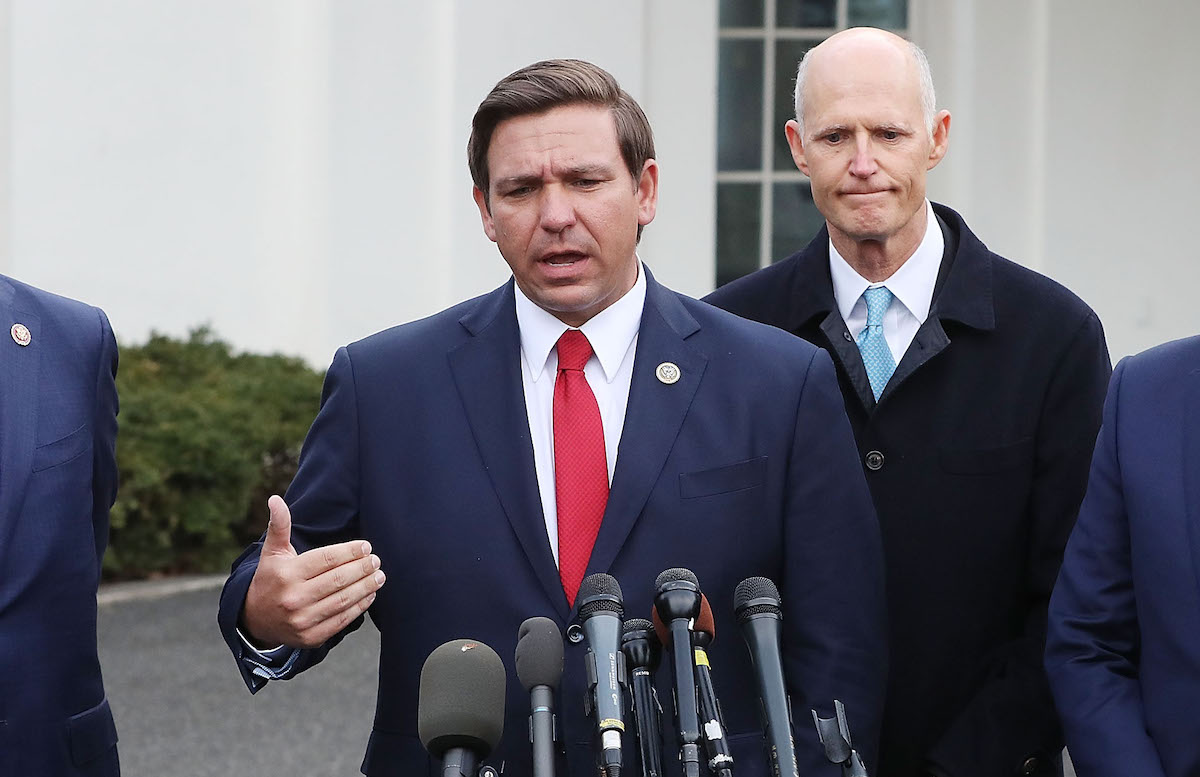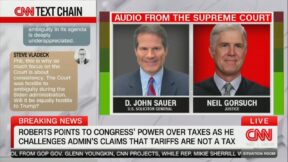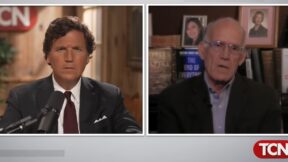Why Did the GOP Let Ron DeSantis and Rick Scott Cannibalize The Party’s 2022 Funds to Prop Up Their 2024 Ambitions?

Photo by Mark Wilson/Getty Images
With the Republican “red wave” failing to materialize in the midterm elections — and no shortage of finger pointing going on as ambitious Republicans seek to absolve themselves of fault and elbow their rivals out of the way — one question that should be asked is why did the GOP allow Florida Gov. Ron DeSantis (R) and Sen. Rick Scott (R-FL) to cannibalize the party’s resources?
DeSantis’ re-election campaign against former Republican governor/former Independent U.S. Senate candidate/current Democratic Congressman Charlie Crist was predicted to be a wipeout by virtually all political observers from the beginning.
There were a few brief moments of wondering if the Supreme Court’s Dobbs decision might boost Democratic turnout or if the Venezuelan migrants DeSantis flew from Texas to Martha’s Vineyard might roll back progress Florida Republicans have made in recent years with Hispanic voters, but neither seemed to have been a factor in the end.
And when President Joe Biden praised the DeSantis administration’s response to Hurricane Ian in early October, it was viewed as the final nail in the coffin for Crist’s hopes for victory. “2022 race for Florida Governor is officially over,” was the blunt assessment by Florida Politics publisher Peter Schorsch.
2022 race for Florida Governor is officially over. https://t.co/U1cxTsK0MU
— Peter Schorsch (@PeterSchorschFL) October 5, 2022
Nationally, multiple polls of key races proved to be inaccurate by overestimating support for Republican candidates, but in the Florida gubernatorial contest they erred by underestimating votes for DeSantis. For months, polls showed DeSantis with a lead of 10 to 15 points, ending up with a final RealClearPolitics polling average of DeSantis +12.2.
In the actual election, Florida voters preferred DeSantis by nearly 20 points: he won with 59.4% (over 4.6 million votes) compared to Crist’s 40% (over 3.1 million votes). Crist prevailed in only five of Florida’s 67 counties (Broward, Orange, Alachua, Leon, and Gadsden), with the Republicans notably flipping Miami-Dade County red.
The financial disparity between the two candidates was even larger than their vote totals. DeSantis collected an astonishingly massive war chest, amplified by small-dollar donations from supporters across the country, and was the top fundraiser nationally out of all gubernatorial candidates, according to the Tampa Bay Times.
According to the most recent campaign finance reports on the Florida Division of Elections website (with data through Nov. 3), DeSantis’ direct campaign took in over $28 million in monetary donations and the Friends of Ron DeSantis PAC piled up nearly $209 million. Crist’s fundraising looks laughably anemic in comparison with not even $18 million for his campaign and even less than that for the Friends of Charlie Crist PAC.
DeSantis Campaign: $28,456,899.19
DeSantis PAC: $208,925,115.39
DeSantis Total: $237,382,014.58Crist Campaign: $17,624,450.88
Crist PAC: $13,959,711.30
Crist Total: $31,584,162.18
Florida law allows PACs to directly communicate and coordinate their activities with the campaigns of the candidates they are supporting, meaning Crist went up against an incumbent governor armed with barely 13% of the Republican’s financial resources.
With so many competitive races across the U.S., you might assume that the Republican Governors Association, tasked with helping elect and re-elect GOP governors, would not have spent much money in Florida this year. You might assume that if the RGA did donate to DeSantis, they certainly wouldn’t have made it a priority race.
Such assumptions, although reasonable, would be wrong.
Below is a screenshot of the RGA’s donations to the Friends of DeSantis PAC for 2021-2022 through the most recent state campaign finance report (through Nov. 3), adding up to $20,950,000.

Screenshot Florida Division of Elections website.
Just looking at the first six months of the year, about one out of every four dollars the RGA spent was sent to DeSantis, who was sitting on hundreds of millions of dollars. The final two contributions — $3 million on Sept. 30 and $600,000 on Nov. 3 — were made well after Crist won his primary and had shown no signs of being able to trip DeSantis on his pathway to victory.
It’s not clear that the nearly $21 million the RGA burned in the Sunshine State could have saved struggling Trump-endorsed candidates like Doug Mastriano in Pennsylvania, but Arizona might have been a different story, where GOP nominee Kari Lake fell short against Secretary of State Katie Hobbs (D) by a razor-thin margin.
Lake did not launch her first television ad of the general election until late September, according to an Axios report, which described her campaign’s TV presence as “paltry.” Axios noted that RGA did drop more than $4 million on ads attacking Hobbs, and sent $6.5 million to the Yuma County Republican Party to buy more ads for Lake’s benefit, but that’s still less than half what they dropped into DeSantis’ PAC.
With Hobbs’ margin of victory over Lake a mere 0.6 percent and representing just over 17,000 votes, it’s highly plausible that the nearly $21 million the RGA dropped in Florida could have nudged Lake into a win.
Turning to Scott and his rocky stewardship of the National Republican Senatorial Committee (NRSC), there has been a lot of Monday morning quarterbacking as the GOP copes with failing to retake control of the Senate, including a failed bid by Scott to oust Sen. Mitch McConnell (R-KY) as minority leader, but there were obvious warning signs of trouble well before Election Day.
A Sept. 3 article by The New York Times‘ Shane Goldmacher described how the NRSC had collected $181.5 million by the end of July but burned through 95 percent of it on an ill-conceived foray into digital advertising, list-building efforts that never paid off, aggressive fundraising tactics that were denounced as unethical, and consultant expenses.
The financial struggles led to the NRSC canceling TV ad buys in hotly-contested Arizona, Pennsylvania, and Wisconsin. Incumbent Sen. Ron Johnson (R-WI) fended off his Democratic challenger, but both Blake Masters in Arizona and Mehmet Oz in Pennsylvania lost.
Scott’s rivals dunked on his leadership of the NRSC by calling it the “National Rick Scott Committee,” as reported by various anonymous sources in media reports, pointing to examples like his September jaunt to Iowa, a state where incumbent Sen. Chuck Grassley (R-IA) could have gone fishing for the entirety of 2022 and still breezed to re-election.
The release of Scott’s “11 Point Plan to Rescue America” was derided as self-promotion by the Florida senator and a trial run for a future presidential campaign. The agenda was publicly dismissed by McConnell — although that didn’t stop Democrats from using it as campaign fodder to attack Republicans, specifically regarding the cuts to Medicare and Social Security.
The whole mess raises the question of how Scott was tapped to lead the NRSC in the first place. True, it’s a difficult and demanding position, and he did run unopposed, but did GOP leadership really forget his history in Florida when they encouraged him to take over the NRSC?
Scott ran for governor in 2010 as a first-time candidate, playing up his outsider status and boosting his campaign with millions of dollars of his own money to knock down then-Florida Attorney General Bill McCollum (R), who had the support and endorsement of virtually every elected official and party leader in the state, due to his decades-long political career.
After Scott won that bitterly-fought primary, the Republican Party of Florida (RPOF) scrambled to get everyone on board, with calls going out to Republican legislators, city and county officials, and party staff and volunteers to show up to various “unity” events as Scott toured the state to energize the GOP for his general election battle against CFO Alex Sink (D). I was an active member with the Orange County Republican Executive Committee at that time, having served as the group’s general counsel and heading up poll watcher training, and made numerous of those phone calls myself.
The party support helped Scott narrowly beat Sink by just over one percent, but he didn’t return the favor. He was not the visible fundraising presence that past Republican governors had traditionally been for the state party, even pulling hundreds of thousands of dollars he had raised out of an RPOF account after a feud over who would serve as the next RPOF chair and physically moving his political committee’s office location away from the space it had shared with RPOF.
Scott and RPOF declared somewhat of a truce as the 2016 elections approached, but throughout his governorship, Scott was far more an aggressive fundraiser and advocate for his own political committee than he ever was for RPOF. The static between the governor and the state party was a real, evident, and ongoing problem, leading to real financial woes for RPOF during Scott’s time in Tallahassee.
Follow Mediaite’s coverage of the 2022 midterms here.
This is an opinion piece. The views expressed in this article are those of just the author.




